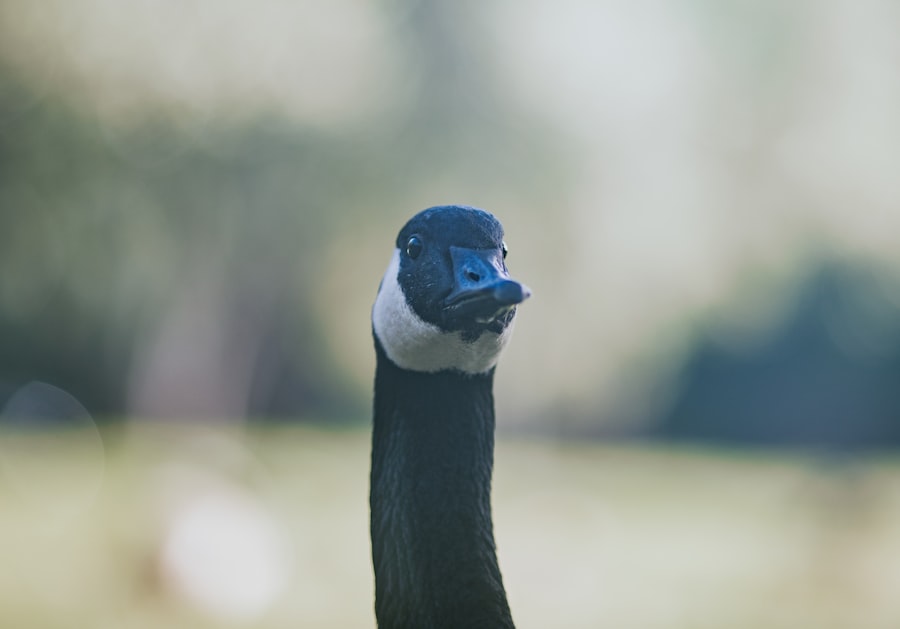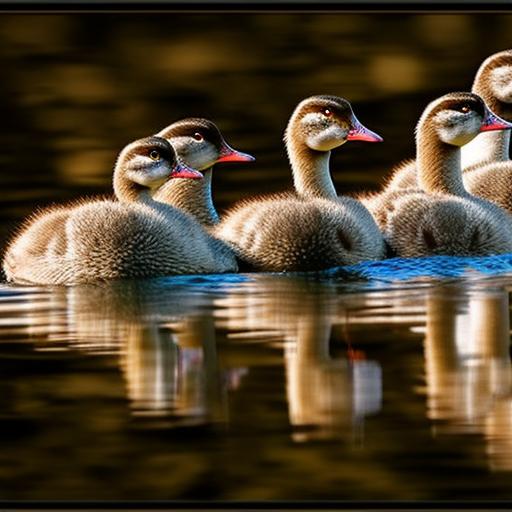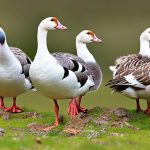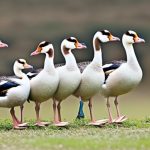Breeding geese has a long history that dates back thousands of years. Geese were domesticated in ancient Egypt and have been bred for their meat, eggs, feathers, and even as guard animals. Today, breeding geese is a popular activity for farmers and homesteaders due to the many benefits it offers.
One of the main benefits of breeding geese is the production of meat and eggs. Geese are known for their flavorful and lean meat, which is in high demand by consumers. Additionally, goose eggs are larger than chicken eggs and have a rich and creamy taste. Breeding geese also provides an opportunity to generate income through the sale of goslings, feathers, and other byproducts.
To successfully breed geese, there are some basic requirements that need to be met. First and foremost, geese require adequate space to roam and graze. They are social animals and thrive in flocks, so it is important to have enough space for them to interact with each other. Additionally, geese need access to clean water for drinking and bathing, as well as shelter to protect them from extreme weather conditions.
Key Takeaways
- Breeding geese requires understanding their reproductive cycle and creating the ideal environment for breeding.
- Selecting the right breeds for your farm or homestead is crucial for successful breeding.
- Natural and artificial insemination both have their advantages and disadvantages for breeding geese.
- Caring for geese during the breeding process involves proper feeding, watering, and health management.
- Managing breeding flocks requires maintaining genetic diversity and avoiding inbreeding to ensure healthy offspring.
Selecting the Right Breeds for Your Farm or Homestead
When it comes to selecting breeds for breeding geese, there are several popular options to choose from. Some of the most common breeds include Toulouse, Embden, Chinese, and African geese. Each breed has its own unique characteristics and advantages.
When selecting breeds for your farm or homestead, there are several factors to consider. First and foremost, you need to determine your goals for breeding geese. Are you primarily interested in meat production or egg production? Do you want geese that are good foragers or ones that are more docile? Answering these questions will help you narrow down your options.
It is also important to consider the climate and environment in which you live. Some breeds are better suited to cold climates, while others thrive in warmer regions. Additionally, you need to consider the space you have available and the resources you can provide. Some breeds require more space and feed than others, so it is important to choose breeds that are compatible with your farm or homestead.
Creating the Ideal Environment for Breeding Geese
Creating the ideal environment for breeding geese is crucial for their health and well-being. Geese require proper housing, feeding, and a clean environment to thrive.
When it comes to housing, geese need a shelter that protects them from extreme weather conditions, predators, and provides enough space for them to move around comfortably. The shelter should have good ventilation to prevent the buildup of moisture and ammonia from their droppings. It is also important to provide nesting boxes or areas where geese can lay their eggs.
Feeding geese a balanced diet is essential for their health and reproductive success. Geese are grazers and should have access to fresh grass or pasture. Additionally, they should be provided with a commercial feed that is specifically formulated for geese. This feed should contain the necessary nutrients, vitamins, and minerals that geese need for optimal health and reproduction.
Maintaining a clean and healthy environment is also important for breeding geese. Geese produce a large amount of droppings, so it is important to regularly clean their housing area to prevent the buildup of bacteria and parasites. Providing clean water for drinking and bathing is also crucial for their health and hygiene.
Understanding the Reproductive Cycle of Geese
Understanding the reproductive cycle of geese is essential for successful breeding. Geese have unique mating habits, egg-laying processes, and signs of successful breeding.
Geese are monogamous animals, meaning they mate with one partner for life. They typically form pair bonds during their first year and remain together until one partner dies. During the mating season, which usually occurs in the spring, geese engage in courtship displays and rituals. The male will often chase the female, honk loudly, and perform various displays to attract her attention.
After mating, female geese will lay eggs. The number of eggs laid can vary depending on the breed and individual goose. Geese typically lay one egg every other day until they have laid a clutch of eggs. Once the clutch is complete, the female will begin incubating the eggs.
The incubation period for goose eggs is approximately 28-35 days. During this time, the female will sit on the eggs to keep them warm and provide the necessary heat for them to develop. It is important to provide a quiet and secure area for the female to incubate her eggs, as any disturbances can cause her to abandon the nest.
Natural vs. Artificial Insemination: Which is Better for Breeding Geese?
When it comes to breeding geese, there are two main methods of insemination: natural and artificial. Each method has its own pros and cons, and the choice depends on various factors such as breeding goals, availability of males, and breeding success rates.
Natural insemination involves allowing geese to mate naturally without any human intervention. This method is often preferred by breeders who want to maintain genetic diversity and natural behaviors in their flocks. Natural insemination also eliminates the need for specialized equipment and techniques.
However, natural insemination can be challenging in some cases. It requires having a sufficient number of males available for mating, as well as ensuring that each female is successfully mated. Additionally, natural insemination may not be suitable for breeders who want to control specific traits or improve breeding success rates.
On the other hand, artificial insemination involves manually collecting semen from a male goose and introducing it into a female’s reproductive tract. This method allows breeders to control the breeding process more precisely and increase the chances of successful fertilization. Artificial insemination is often used in commercial breeding programs to maximize genetic potential and improve breeding success rates.
However, artificial insemination requires specialized equipment and techniques, as well as the knowledge and skills to perform the procedure correctly. It can also be time-consuming and labor-intensive, especially for small-scale breeders.
Choosing the right method for your breeding program depends on your specific goals, resources, and preferences. Some breeders may choose to use a combination of both methods to achieve their desired outcomes.
Caring for Geese During the Breeding Process: Feeding, Watering, and Health

Proper care and nutrition are crucial for the health and well-being of breeding geese. During the breeding process, geese have specific nutritional requirements, watering needs, and are susceptible to certain health issues.
Breeding geese require a balanced diet that provides them with the necessary nutrients for optimal reproductive performance. They should be fed a high-quality commercial feed that is specifically formulated for breeding geese. This feed should contain adequate protein, vitamins, minerals, and energy to support egg production and fertility.
In addition to commercial feed, geese should also have access to fresh grass or pasture. Grazing allows geese to consume natural vegetation, which provides additional nutrients and helps maintain their digestive health. It is important to ensure that the grazing area is free from toxic plants or chemicals that could harm the geese.
Watering is also essential for breeding geese. Geese require clean and fresh water for drinking and bathing. They should have access to a shallow pool or pond where they can immerse themselves in water to clean their feathers and cool down during hot weather. It is important to regularly clean and refill their water sources to prevent the buildup of bacteria or algae.
During the breeding process, geese may be susceptible to certain health issues. Common health problems in breeding geese include egg binding, respiratory infections, and parasites. It is important to monitor the health of your geese regularly and seek veterinary care if necessary. Providing a clean and hygienic environment, as well as a balanced diet, can help prevent many health issues.
Hatching and Raising Goslings: Tips and Tricks for Success
Hatching and raising goslings can be an exciting and rewarding experience. However, it requires careful attention to detail and proper care to ensure the health and survival of the goslings.
The incubation period for goose eggs is approximately 28-35 days. During this time, it is important to provide a quiet and secure area for the female to incubate her eggs. Any disturbances or stress can cause her to abandon the nest or neglect the eggs.
Once the eggs start hatching, it is important to provide a warm and safe environment for the goslings. A brooder box or pen with a heat source, such as a heat lamp or heating pad, should be set up to maintain the ideal temperature for the goslings. The temperature should be gradually reduced over time as the goslings grow and develop their feathers.
Feeding goslings a balanced diet is crucial for their growth and development. They should be provided with a commercial starter feed that is specifically formulated for goslings. This feed should contain adequate protein, vitamins, minerals, and energy to support their rapid growth. It is important to provide fresh water at all times and monitor their feeding behavior to ensure they are eating enough.
Raising goslings requires regular monitoring of their health and well-being. They should be checked daily for any signs of illness or injury. It is also important to provide them with plenty of space to move around and exercise. As they grow, they can be gradually introduced to outdoor areas where they can graze and explore.
Managing Breeding Flocks: Maintaining Genetic Diversity and Avoiding Inbreeding
Managing breeding flocks is essential for maintaining genetic diversity and avoiding inbreeding. Genetic diversity is important for the long-term health and productivity of the flock, while inbreeding can lead to reduced fertility, increased susceptibility to diseases, and other health issues.
To maintain genetic diversity, it is important to introduce new bloodlines into the flock periodically. This can be done by purchasing new breeding stock from reputable breeders or participating in breed conservation programs. It is also important to avoid breeding closely related individuals, as this increases the risk of inbreeding.
Keeping detailed records of the breeding history and lineage of each individual in the flock is crucial for managing genetic diversity. This allows breeders to track the relatedness of individuals and make informed breeding decisions. Breeding pairs should be carefully selected to ensure that they are not closely related and have desirable traits.
Inbreeding can be avoided by implementing a breeding program that focuses on outcrossing and maintaining genetic diversity. Outcrossing involves mating individuals that are not closely related to each other, which helps introduce new genetic material into the flock. It is also important to monitor the health and reproductive performance of the flock regularly to detect any signs of inbreeding depression.
Marketing and Selling Geese: Finding the Right Market for Your Breeding Program
Once you have successfully bred geese, it is important to find the right market for your products. There are several potential markets for geese, including meat, eggs, feathers, and live birds.
The meat market for geese is growing due to increasing consumer demand for high-quality and locally sourced products. Selling goose meat can be done through direct sales to consumers, farmers markets, restaurants, or specialty food stores. It is important to market your product as a premium and sustainable option that offers superior taste and nutritional value.
Goose eggs are also in demand by consumers who are looking for a unique and flavorful alternative to chicken eggs. Selling goose eggs can be done through direct sales, farmers markets, or specialty food stores. It is important to educate consumers about the benefits of goose eggs and how to use them in cooking and baking.
Feathers from geese can be sold to crafters, fly fishermen, or other individuals who use feathers for various purposes. Selling feathers can be done through online platforms, craft fairs, or specialty stores. It is important to provide high-quality feathers that are clean and free from damage.
Live birds can be sold to other breeders, homesteaders, or individuals who want to raise geese for various purposes. Selling live birds can be done through online platforms, classified ads, or local poultry auctions. It is important to provide healthy and well-socialized birds that are suitable for their intended purpose.
Challenges and Opportunities in Breeding Geese: Navigating the Industry in the Modern World
Breeding geese comes with its own set of challenges and opportunities. Navigating the industry in the modern world requires staying up-to-date with the latest trends, embracing innovation, and adapting to changing consumer demands.
One of the main challenges in breeding geese is competition from other poultry products. Chicken and turkey are more popular and widely available options for meat and eggs, which can make it challenging to find a niche market for geese. However, there is a growing demand for high-quality and locally sourced products, which presents an opportunity for breeders who can meet these demands.
Another challenge is the increasing regulations and restrictions on poultry farming. Breeding geese may require compliance with zoning regulations, animal welfare standards, and biosecurity measures. It is important to stay informed about these regulations and ensure that your breeding operation meets all the necessary requirements.
On the other hand, there are several opportunities for innovation and growth in the geese breeding industry. One such opportunity is the development of new breeds or hybrids that are better suited to specific climates or production systems. There is also an opportunity to explore alternative markets, such as pet geese or therapy animals.
Navigating the industry in the modern world requires staying informed about the latest trends and consumer preferences. It is important to conduct market research, attend industry events, and network with other breeders to stay ahead of the curve. Embracing technology and social media can also help promote your breeding program and reach a wider audience.
In conclusion, breeding geese can be a rewarding and profitable venture for farmers and homesteaders. Understanding the basics of breeding geese, selecting the right breeds, creating an ideal environment, and managing the breeding process are key to success. By navigating the challenges and embracing the opportunities in the industry, breeders can thrive in the modern world and contribute to the sustainability of this ancient practice.
If you’re interested in breeding geese, you may also find this article on poultrywizard.com helpful. It discusses the importance of providing adequate space for chickens in a coop and answers the question, “How big does a coop need to be for a chicken?” Understanding the space requirements for chickens can also be beneficial when considering the housing needs of geese. Check out the article here to learn more about creating a suitable living environment for your feathered friends.
FAQs
What is breeding of geese?
Breeding of geese refers to the process of raising and reproducing geese for various purposes such as meat, eggs, feathers, and as pets.
What are the different breeds of geese?
There are many breeds of geese, including Toulouse, Embden, African, Chinese, and Canadian. Each breed has its own unique characteristics and is suited for different purposes.
What is the best time to breed geese?
The best time to breed geese is during the spring season, which is from March to May. During this time, the weather is mild, and the geese are more active and fertile.
What is the lifespan of geese?
The lifespan of geese varies depending on the breed and the living conditions. Generally, geese can live up to 20 years in captivity and up to 10 years in the wild.
What is the gestation period of geese?
The gestation period of geese is around 28 to 30 days. During this time, the female goose will lay and incubate her eggs until they hatch.
What is the average clutch size of geese?
The average clutch size of geese is around 5 to 12 eggs. However, this can vary depending on the breed and the age of the female goose.
What is the feeding requirement for breeding geese?
Breeding geese require a balanced diet that includes grains, vegetables, and protein sources such as insects or fish. They also need access to clean water for drinking and bathing.
What are the common health issues in breeding geese?
Common health issues in breeding geese include respiratory infections, parasites, and egg binding. It is important to provide proper care and nutrition to prevent these health issues.
Meet Walter, the feathered-friend fanatic of Florida! Nestled in the sunshine state, Walter struts through life with his feathered companions, clucking his way to happiness. With a coop that’s fancier than a five-star hotel, he’s the Don Juan of the chicken world. When he’s not teaching his hens to do the cha-cha, you’ll find him in a heated debate with his prized rooster, Sir Clucks-a-Lot. Walter’s poultry passion is no yolk; he’s the sunny-side-up guy you never knew you needed in your flock of friends!







